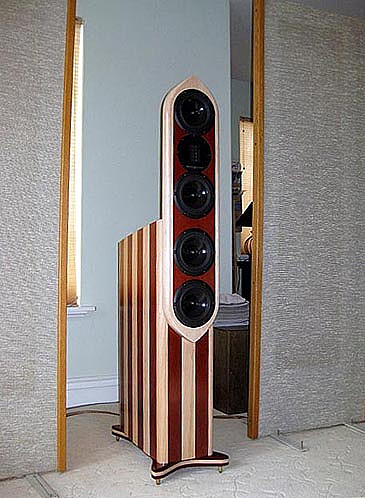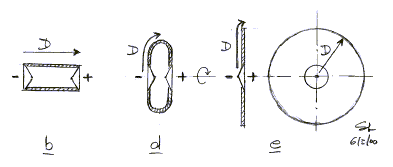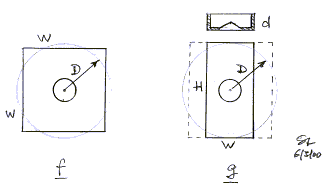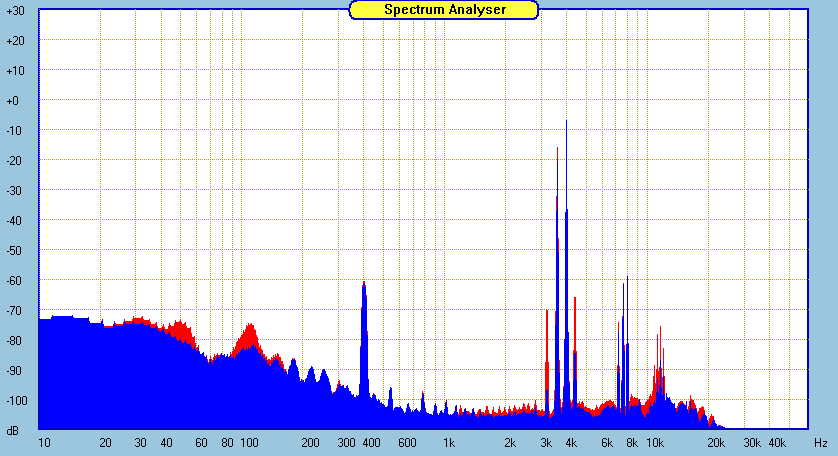I understand what you write. You say a lot of things but I give you my point of view, a little slight different. I talk about things I experiment. I made active and passive OB. I began by a passive one, I had a lot of difficulties, at the end I made an active one and its works. I read all publications (thanks for their great website) from SL, MJK, and JK. I understand what happened and I managed to make a decent passive OB.
All designs in HiFi need compromise ? Isn't it ? You cannot have good bass extension and narrow OB baffle ?
Large ? what is a large baffle ? My open baffle width is 40cm ? it is large ? and the last OB full-range I made is 30cm width. Just as large as the driver.
The sensitivity of the passive OB speaker is low 83dB/2.83V.
If the debate is about passive versus active. During a long time I thought active is better than passive till I have had a good amplifier. But if you never experiment this, you cannot believe this. I think it's easier to make a better active design for practical reasons (e.g. better amplifier inter-modulation).
Large inductor is to equalize in the bass and lower midrange, why is so problematic ? Passive box subwoofer, 3 ways box, use large inductor.
For the driver, it is problematic to find high end drivers design for close box and open baffle. A majority of drivers are design for bass reflex. You have to equalize a lot and only with active filter.
Things are not simple or black or white. You often have exceptions
Ultimately both passive and active designs are possible. The major difference will be that with a passive design any required eq generally results in lowering the system sensitivity. This typically is associated with the low frequency cut off of the woofer. So with a passive system there is typically a lot of amplifier head room wasted in the crossovers and eq. This is similar to the reduction in sensitivity we have when we compensate a simple 2-way for the baffles step; above the baffle step we are basically throwing away 6dB (or whatever) of amplifier head room. Now, in a 3-way, there generally isn't a lot of wasted head room between the tweeter and mid which is why I favor a hybread approach: passve mid to tweeter, with active mid to woofer x-o and active eq.
Hi All,
I have been following this thread in order to learn a bit about OB/dipole woofer design - I am quite new to this design, having stuck with closed/vented box designs in the past. I understand the low freq. rolloff and the necessary eq. for it but what is this dipole peak I'm reading about and how do you calculate it?
I have been following this thread in order to learn a bit about OB/dipole woofer design - I am quite new to this design, having stuck with closed/vented box designs in the past. I understand the low freq. rolloff and the necessary eq. for it but what is this dipole peak I'm reading about and how do you calculate it?
I never posted anything here about my MJAO G 098 an anagram of the JAMO R 909/907 speakers. It's a three-way passive OB design closly following the Jamo.
It uses 2 Eminence Alpha 15s for bass, the Monacor MS-100CHQ for mid and Monacor DT-28N in the treble. I actually dumped Monacor RBT-95 magnetostatic tweeter in favour of the dome. Baffle dimensions are 40 cm x 110/120 cm. It has been built by some people around the world with at least as they say good result.
It looks like this, left hand speaker, right is a mirror copy:
Crossover was 6 dB/octave allover, 300 Hz bass-mid and 4000 Hz mid-top. But both Zobel and a notch was necessary on the Alphas to tame the 2 kHz peak:
Respone measured like this for the right hand speaker at sweetspot 2.5 m from the speaker in my living room:
The speaker produces very good. Today a good candidate for midrange would have been Monacor SP-8/150PRO a neutral 8 inch unit with good Xmax and powerhandling and with the same efficiency to fit with the other two. Mid-top crossover would then probably be somwhere 2500-3000 Hz. The 10 cm MS-100CHQ is a bit to small to play real high with.
/Erling
It uses 2 Eminence Alpha 15s for bass, the Monacor MS-100CHQ for mid and Monacor DT-28N in the treble. I actually dumped Monacor RBT-95 magnetostatic tweeter in favour of the dome. Baffle dimensions are 40 cm x 110/120 cm. It has been built by some people around the world with at least as they say good result.
It looks like this, left hand speaker, right is a mirror copy:
An externally hosted image should be here but it was not working when we last tested it.
Crossover was 6 dB/octave allover, 300 Hz bass-mid and 4000 Hz mid-top. But both Zobel and a notch was necessary on the Alphas to tame the 2 kHz peak:
An externally hosted image should be here but it was not working when we last tested it.
Respone measured like this for the right hand speaker at sweetspot 2.5 m from the speaker in my living room:
An externally hosted image should be here but it was not working when we last tested it.
The speaker produces very good. Today a good candidate for midrange would have been Monacor SP-8/150PRO a neutral 8 inch unit with good Xmax and powerhandling and with the same efficiency to fit with the other two. Mid-top crossover would then probably be somwhere 2500-3000 Hz. The 10 cm MS-100CHQ is a bit to small to play real high with.
/Erling
Last edited:
for ease of build have you considered a kit?
GR Research
--
$895.00usd
They also have a smaller set called the ob5 @ $815.00.

GR Research
An externally hosted image should be here but it was not working when we last tested it.
--
$895.00usd
The upper MTM section consists of a pair of M-130/16's crossing in the 1,800Hz range to a BG Neo 3 pdr. The crossover point of the open baffle MTM section to the lower four woofers is in the 180Hz range.
The kit comes with everything you need aside from tools and cabinet materials.
Crossover components include Alpha Core foil inductors for everything except the low pass on the four M-130 woofers. It uses an Erse laminated I core. Caps are a combination of Erse poly caps with Sonicap Gen.2 by-pass caps and Sonicaps. Resistors are Mills and Lynk. Other components include the best binding posts from Vampire Wire. Eight good looking, solid Brass floor spikes, OFC wire, screws, solder, and heat shrink are also included
They also have a smaller set called the ob5 @ $815.00.
D is the acoustic distance between the two dipole sources as seen by the listener. Linkwitz shows the 'evolution' of D from the source distance to D= baffle radius in these figures:Linkwitz keeps saying D=xxx - what is D? Diameter? Depth? What?


As you can see, D ist NOT half the width of an rectangular OB, but the radius of an equivalent disk. The effective D of any rectangular OB can easily be determined by using EDGE.
I show at my web site that any flat baffle is equivalent to a circular baffle at low frequency. The baffle actual shape ultimately come into play about an octave below the dipole peak of the equivalent circular baffle.
An externally hosted image should be here but it was not working when we last tested it.
Thanks guys! I have enough supplies left over from various speaker projects that I am not considering a kit at this time. I'm just trying to construct some reasonable protos to investigate and learn about dipole woofers - i.e., how large a baffle you have to have to get down to around 45hz, how bad the response falls off, how high up in freq. you could push those woofers to, could they be used in a two way, etc. Nothing like digging in and seeing what works and what doesn't.
for ease of build have you considered a kit?
GR Research
An externally hosted image should be here but it was not working when we last tested it.
--
$895.00usd
They also have a smaller set called the ob5 @ $815.00.

i read a review on audioreviews that said ob5 can be a bit harsh on the highs and that statement alone stopped me from further research. however, with a further looking into from your recommendation, i can conclude that these are also darn fine deals. and probably the only ready to build kit option i have within my budget. OB5 is suppose to have 91 db according to gr-research. if they're not being generous about the specs.. this could be a real deal breaker for me since knowing that my tube amp sits gathering the dust always makes me feel guilty. i imagine OB7's sensitivity could only be equal or greater. is BG neo3 a true ribbon though? it's usable frequency is only up to 20k compared to 40k of founteks among others which i'm guessing could only mean that it will have less 'air'. i may pull the trigger on OB8 this week. main reason why i choose this over RC3R from selah audio is.. they're not replying to my emails... i sent an email to rick 3 days ago and once again with nothing back. what if my order gets delayed the same way once it's paid? speed is integrity with an online business...
i read a review on audioreviews that said ob5 can be a bit harsh on the highs and that statement alone stopped me from further research. however, with a further looking into from your recommendation, i can conclude that these are also darn fine deals. and probably the only ready to build kit option i have within my budget. OB5 is suppose to have 91 db according to gr-research. if they're not being generous about the specs.. this could be a real deal breaker for me since knowing that my tube amp sits gathering the dust always makes me feel guilty. i imagine OB7's sensitivity could only be equal or greater. is BG neo3 a true ribbon though? it's usable frequency is only up to 20k compared to 40k of founteks among others which i'm guessing could only mean that it will have less 'air'. i may pull the trigger on OB8 this week. main reason why i choose this over RC3R from selah audio is.. they're not replying to my emails... i sent an email to rick 3 days ago and once again with nothing back. what if my order gets delayed the same way once it's paid? speed is integrity with an online business...
I have heard nothing but good about Danny and GR Research's customer service. As for harsh highs, I love ribbon tweets, and use a modified Aurum Cantus ribbon with single OB mid and a side-mounted woofer. I have found that this tweeter can be harsh with Class-D Rotel (ICE) amps, yet super smooth with a class a/b marantz.
Not sure if the Neo 3 is a 'true' ribbon or not, but it has been used by GR Research for some time. GR has a forum at AudioCircle to discuss there stuff.
Here is some info on the Neo 3:
Zaph|Audio
# Fountek NeoCD2.0 ($118) - Comparitively durable ribbon element. Of the three true ribbons, this has the best performance above 4kHz. It has the worst performance at 2kHz, rendered somewhat irrelevant because they are all terrible at 2Khz. It's excellent 4kHz+ performance is more obvious in the HD sweeps than the single and multitone spectrums however. Smooth response curve. Poor vertical off axis response.
# Bohlender Graebener Neo3 PDR ($55 w/flange) - This B&G tweeter outperformed everything here, in most cases by a large margin. Response curve is ok, but nonlinear distortion is excellent. This is a very clean and natural sounding tweeter. Note: these were tested with the rear chamber in place. Later, with a different pair, I also tested with the chamber removed. The tweeter was far too overdamped in that case, and I recommend leaving the rear chamber installed.
4000Hz
Blue = Neo3 PDR
Red = NeoCD2.0

Last edited:
Stealing topic,
I'm dipole newbie. Is there any way possible to do good full range dipole for passive amplification. I really don't want any eq's and stuff in my home. Bi amping is not problem but should be with simple passive XO and dipole correction. Maybe 15" woofer + 3-6" fullrange?
Any good topics of that kind speakers?
I'm dipole newbie. Is there any way possible to do good full range dipole for passive amplification. I really don't want any eq's and stuff in my home. Bi amping is not problem but should be with simple passive XO and dipole correction. Maybe 15" woofer + 3-6" fullrange?
Any good topics of that kind speakers?
- Status
- This old topic is closed. If you want to reopen this topic, contact a moderator using the "Report Post" button.
- Home
- Loudspeakers
- Multi-Way
- New project- open baffle recommandations?